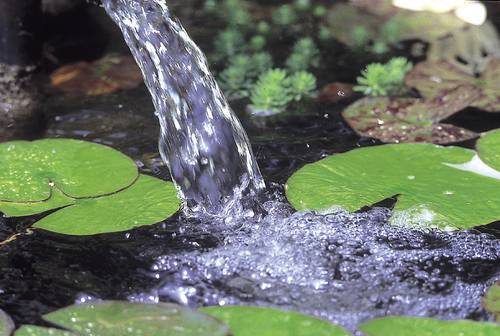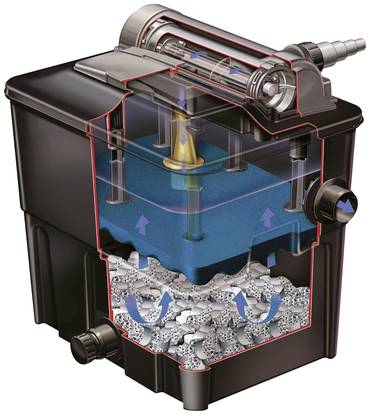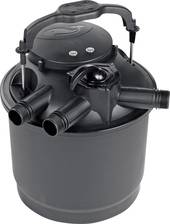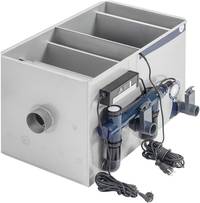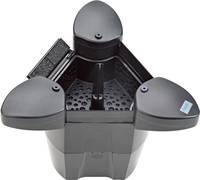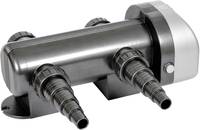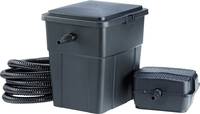Pond filter » The right technology for clean and clear water in the pond
Published: 12.08.2021 | Reading time: 7 minutes
This text is machine translated.
A natural pond that is sufficiently large and deep does not need a pond filter for clean water. Especially if the bank, shallow water and deep water zones are planted with plants appropriate to the location.
But even if there are very few fish in the pond, this has a positive effect on the water quality. Over time, a biological equilibrium will establish itself in which the pond ecosystem regulates itself.
Unfortunately, in most cases this self-regulation does not work with an artificial pond in the front garden or on company premises. This is because there is often no natural inlet and outlet to ensure a continuous exchange of water.
This is why plant debris, suspended matter and other impurities must be reliably filtered out of the water in a garden pond. We will be happy to show you how modern pond filters achieve this.
The water in a garden pond is contaminated with many “impurities”. This applies to smaller ponds as well as large ponds. Pollen, leaves or dead insects float on the surface of the water. Plant debris, excess fish food or sediment stirred up by fish float in the water. All in all, these are potential sources of nutrients for algae. With an oversupply of food and favorable temperatures, the algae can then multiply explosively.
For clean and clear pond water, these unwanted substances must be filtered out as well as possible. Different filter stages are used to remove all suspended matter from the water, from coarse to very fine. A distinction is made between mechanical filtration and biological filtration.
In mechanical filtration, sieves and sponges separate the visible solids from the water. In biological filtration, bacterial cultures convert nitrite and ammonium, which are released when plants rot or by fish excrement, into non-toxic substances.
UVC lamps, which emit light in the UV-C spectral range (ultraviolet, range C), are also used to destroy pathogenic bacteria and germs. The UV light prevents cell division so that the irradiated microorganisms can no longer multiply.
In order for a pond filter to fulfill this demanding task, the pond water must flow through it continuously. The filtered and clear water is then returned to the garden pond.
A pond filter consists of a watertight housing with inlet and outlet connections. The water to be cleaned is supplied via an internal or external pond pump.
Inside the housing, the water to be cleaned is passed through one or more filter elements made of a wide variety of materials such as brushes, mats or granulate in corresponding filter densities. Depending on the filter design, the filtered dirt can be removed manually or drained via separate shut-off devices. It is also necessary to clean or replace the filter elements from time to time.
Many filters also have UVC lamps integrated or attached to the side for disinfection. The ultraviolet light damages the DNA of the microorganisms, preventing them from reproducing and causing them to die. Depending on the design, pond filters can either be completely installed in underground shafts or partially buried. This depends, among other things, on the water and pressure conditions. Devices in different designs are available for this purpose.
Pressure filter
A pressure filter consists of a closed container with filter materials and hose connections. The water is forced through the filter by a pump.
As a pressure filter can withstand high pressure, it can bridge height differences. These filters are therefore ideal in combination with waterfalls, streams or fountains.
The filter is installed outside the pond and can be located above or below the water level.
Flow filter
Flow-through filters are also installed outside the pond. However, the water does not run through the filter under pressure.
To ensure that the filtered water can flow back into the garden pond, the installation location of a flow-through filter must always be above the water level. This can make concealed installation difficult under certain circumstances.
Flow-through filters do not require as much pump power as pressure filters and can also be easily opened and cleaned during operation.
Surface filter
These cleaning devices, also known as skimmers, are used to keep the water surface clean.
They are either connected to a pond pump via pipes or hoses or have an integrated pump.
The important thing about surface filters is that they can react to fluctuations in the water level. This is why floating surface filters have proven to be very effective.
UVC clarifier
The filters are used to effectively combat pathogenic bacteria and germs, which are particularly prevalent in ponds with a high fish population.
The spread of algae is also reduced as the UVC light destroys the algae spores.
UVC clarifiers can be easily integrated into the filter circuit as an independent stage or connected to existing filters via hose connections.
Filter sets
With a flow-through filter set or pressure filter set, the manufacturer has put together perfectly coordinated components to create a tried and tested set.
Depending on the version, the different filters are equipped with mechanical and biological filter stages as well as UVC technology.
The right pond pumps and the necessary hose lines are also included in the complete set to match the filters. Detailed instructions also make commissioning easier.
There are a few important points to consider when choosing the right pond filter.
Pond size
To make it easier to find the right filter for the existing pond, manufacturers always state the maximum pond size in the technical data. However, the specified value usually refers to ponds without fish. If the pond is stocked with fish or is located in the sun, the maximum volume of the pond filter should be significantly higher.
Filter type
Whether a pressure filter or a flow-through filter should be used also depends on the available space. A pressure filter is more compact and can be installed underground in a shaft. Flow-through filters must be installed above the water level.
Cleaning options
A pond filter must be easy to clean without destroying the bacterial cultures of the biological purification stage. Pressing devices are often used to simply squeeze out the filter mats. Sludge and dirty water can then be easily rinsed out via a drain connection.
Replacement material
Pond filters are equipped with many consumables and wear materials. It makes sense to check the range and prices of filter inserts or UVC components in advance.
Can any pond owner install a pond filter?
In principle, yes. However, if it is a set with an electric pump and UVC unit, the connection must be carried out by a specialist. This is because a wide range of regulations must be observed for the electrical installation. For plug-in systems, check whether the mains socket used is protected by a residual current device with the prescribed rated residual current. Extension leads, plugs and power distributors must be suitable for outdoor use and have the required splash water protection.
Does a pond filter have to run 24 hours a day?
Yes, if the filter has a mechanical-biological filter stage. If the pond pump fails or is switched off, the bacteria will no longer be flushed with oxygenated water and may die off after some time due to a lack of oxygen. If the filter pump is then switched on again, the dead bacteria and the resulting toxins are flushed into the pond.
What is a gravity filter system?
Gravity filter systems are constructed in such a way that the water flows into the filter by itself with all suspended matter and dirt particles. After the last filter stage, a pump transports the clean water back into the pond. As the pump is virtually operated with clear water, the mechanical load on the pump impeller is significantly lower. However, the inlets can become clogged more easily.
